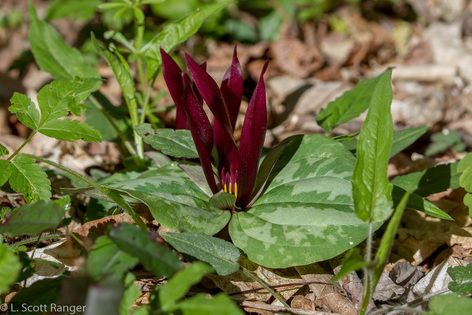Flora of Georgia and surrounding states
Trilliums!
Trillium decumbens Harbison 1902, decumbent or trailing trillium

Georgia has two oddball trilliums that lie on the ground.
Taxonomy
This is the only name this trillium has ever had!
Etymology
The epithet and common name comes from the Latin decumbere, to lie down, recline, referring to the scape.
Some references call it trailing trillium or trailing wakerobin, but I've never heard anyone call it that. "Decumbent" is a very strange word for people to say, so to call this a "common" name is stretching the definition of common, unless one spends all their time with botany types. But then, a large number of them would say Trillium decumbens!
Status
No federal or state status.
NatureServe status is G4 - Apparently Secure but is S3 - vulnerable, in Georgia.
Distribution & Habitat
The Biota of North America has a county-level distribution map.
The UNC Atlas has a county-level distribution map.
The UGA Atlas has a county-level distribution map.
Decumbent trillium is endemic to the southern end of the Cumberland Plateau and Ridge and Valley with most populations in Alabama. Five northwestern counties in Georgia have populations. It can easily be seen on the Shirley Miller Wildflower Trail in the Crockford-Pigeon Mountain Wildlife Management Area of northwest Georgia. It is always found in somewhat open deciduous forests where light makes its way through the canopy in March and April when the plant reaches its peak growth. Many other spring ephemerals are usually in flower at the same time like hepatica, bloodroot and toothwort, all visible in the photo below.
Taxonomy
This is the only name this trillium has ever had!
Etymology
The epithet and common name comes from the Latin decumbere, to lie down, recline, referring to the scape.
Some references call it trailing trillium or trailing wakerobin, but I've never heard anyone call it that. "Decumbent" is a very strange word for people to say, so to call this a "common" name is stretching the definition of common, unless one spends all their time with botany types. But then, a large number of them would say Trillium decumbens!
Status
No federal or state status.
NatureServe status is G4 - Apparently Secure but is S3 - vulnerable, in Georgia.
Distribution & Habitat
The Biota of North America has a county-level distribution map.
The UNC Atlas has a county-level distribution map.
The UGA Atlas has a county-level distribution map.
Decumbent trillium is endemic to the southern end of the Cumberland Plateau and Ridge and Valley with most populations in Alabama. Five northwestern counties in Georgia have populations. It can easily be seen on the Shirley Miller Wildflower Trail in the Crockford-Pigeon Mountain Wildlife Management Area of northwest Georgia. It is always found in somewhat open deciduous forests where light makes its way through the canopy in March and April when the plant reaches its peak growth. Many other spring ephemerals are usually in flower at the same time like hepatica, bloodroot and toothwort, all visible in the photo below.
|
Description
By far the most distinctive character of this trillium are the three bracts that lay directly on the ground because the scape (what most call a stem) is bent into a flattened "S" and lays on the ground. The only other trillium to do this is the relict trillium, Trillium reliquum J.D. Freeman, also found in Georgia along the Chattahoochee and Savannah Rivers. If one carefully digs a few inches or so where the scape comes out of the ground, the large (thumb-sized or bigger) rhizome's growing point always points downhill. The lanceolate (lance-shaped) sepals are usually tinged with maroon. The petals are are rich maroon and stand very erect and are almost as long as the bracts. The petals are very persistent and retain their color long after the bracts have begun to wither, becoming a brown-red as the fruit develops. |
